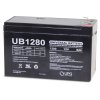@jesse salinas: I think you may have finally "got it". Good point that Harald made in his post #14 about the push-button switch. Make sure it can handle at least two amperes of current. As for the battery... if you are gonna be carrying this around, a belt that holds eight D-size cells, either alkaline (one time use) chemistry or rechargeable LiPO, lithium-ion, or even NiCd (nickel cadmium) or lead-acid chemistry would be better than that clunky, heavy, awkward-to-carry, box-like battery whose image you posted. However, that, too, would work just fine, and it
is rechargeable.
The important thing is to have enough voltage (12 V DC) and enough current capability (2 A) and enough ampere-hours (8 Ahr or more) energy capacity to last for as long as you want to be outside to use it. You might want to consider making your own "battery belt" using commercial off-the-shelf single-cell holders wired in series with an appropriate connector for the LED strip:

If you are only going to pulse the LED string on for a few seconds, a few times per hour or a few times per minute, you may be able to get by with much smaller cells, say, AA-size or C-size instead of D-size. If it were my project, I would gather up eight fresh 1.5 volt AA alkaline cells and wire them up in series, head-to-toe, with short lengths of stranded 18 to 24 AWG insulated wire. Then make a test run to see how long they will last in the field. Wrap the string of cells with duct tape and secure it to your waist to carry comfortably. Once you find a size that works for you, glue single-cell holders to a web-belt, wire them up, and head on out into the field.
I am curious. What the frak is this? An old-fashioned sandwich-board advertising display? Gotta be more attractive than those stupid inflatable hot-dog displays that waggle around to catch your attention...





